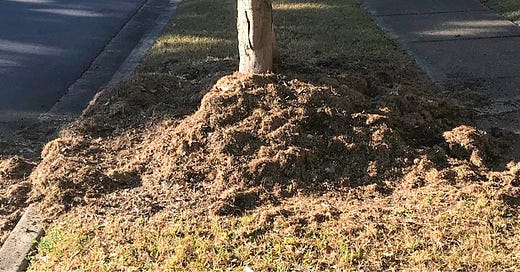Brisbane Tree Canopy Problem
This week the ABC has produced two stories about the failure to meet targets for tree canopy and tree health. This is a serious concern in many ways. How serious are we about solutions?
First the stories. If you’ve not seen them, read them on the ABC site. The stories are factual but the framing is narrow. They offer no solutions, except perhaps larger budgets for tree maintenance. I’d support increased budgets to support our urban trees but that alone won’t make enough difference. This is not a simple problem for councils to fix for us while we carry on as normal.
Brisbane council fails to keep hundreds of thousands of trees in good condition raising risk of damage to property (ABC News, 12 June 2025)
and
Brisbane's shade cover falls short of targets ahead of 2032 Olympics (ABC News, 13 June 2025)
At least, the first story contains the tensions between Council’s aims to increase planting while Energex removes or prunes trees for safety around power lines.
Social media comments, both LinkedIn and Facebook, range from bagging the council to complaining about every level of government, and co-opting the story for their pet issue: Olympics, development, increased housing density, transport, as well as the usual partisan remarks. Some complain about the wrong trees being planted and think they know best about what the council should do.
This problem is occurring around the country, but Brisbane has the added complication of the Olympics to sidetrack discussions and funding.
It’s easy to say that the council should just plant more trees and look after them better. If only it were that easy.
More Street Trees Please
A lot of us want more street trees for many different reasons, including: increasing shade and biodiversity, reducing urban heat, increase walkability, and encourage more active lifestyles. It’s easy to say that the council should just plant more trees and look after them better.
If only it were that easy. A surprising number of people don’t want street trees in front of their homes and they will remove or kill any tree planted there. There are those who park on the verge (illegally) and compress the soil over the roots, the mowers and whippersnippers that damage the trunks, and the volcano mulching.
Don’t kill with kindness! These grass clippings will heat up and eventually kill the tree.
Housing or Cars?
A common complaint is that increased density means smaller yards so there is no room for trees. This is a call to continue low-density, urban sprawl that will destroy even more trees and bushland, albeit out of sight. When I walk around my low-density neighbourhood, I see many large gardens with treeless lawns, lots of paving, and even fake grass while in front of the fence there are cars, boats, trailers, and caravans stored on the verge and road.
However, higher-density housing does mean that street trees and native verge gardens are even more important for cooling, biodiversity, and access to nature. The contest between uses of the space in our streets becomes more obvious.
A Brisbane resident raised a petition in 2024 to Brisbane City Council (BCC) to allow parking on the verge in narrow streets. Their street is not wide enough for cars to park on both sides of the street and leave room for other vehicles to pass. Their proposal means less space for street trees. Car parking is more important than trees.
When you look at an aerial view of your suburb, notice how much space is taken up by roads, intersections, and car parking compared to housing.
How much of that space is lost to trees in order to accommodate the ever-increasing number of private cars in our cities? Speed and driver convenience are also more important than trees.
What if every time a street or road or intersection is maintained or resurfaced, we adjust the balance of the paved area and the space available for planting trees?
What if we all gave street trees a higher priority, with residents providing a verge garden that supports the health and vitality of the trees planted by council?
Read More
How to help street trees thrive
We all know the feeling of walking from the hot sun into the cool shade of a tree.
Could verge gardens make increased housing density more acceptable?
We know that we have to increase urban density and the range of housing options to provide affordable homes for more people within our current urban footprint.
Three things we must do to cool our streets and cities
Heat and shade are on everyone’s agenda these days. Whether it’s the health, walkability, equity, economic, social or other aspect will depend on the organisation’s purpose. But it’s clear to all that we need to reduce urban heat as much as we can and find ways of adapting.








You do a great job of covering multiple angles Gayle. I’m very impressed. And I think you already know where I stand on how cars have ruined our neighbourhoods.
We have a good tree canopy in our backyard. The shade is great and we wouldn’t want it any other way despite the lack of sunlight to grow veggies, or having to pick up seedpods and fallen branches, or the landlord having to spend money on trimming and plumbing. I know someone who had to spend a few tens of thousands $, on his trees after the cyclone and unreasonable neighbours all came together.
There’s a sacrifice, yes, and you’re right to imply we might benefit from a review of our priorities.
Hi Gayle - you might be interested in going to the Drop In at Goodfolk Cafe in Bardon this Monday 23 June 10.00am -12.00- Michael Berkman and Elizabeth Watson-Brown are seeking comments on the BCC proposals for Mt Coot-tha.( They are asking people to RSVP)